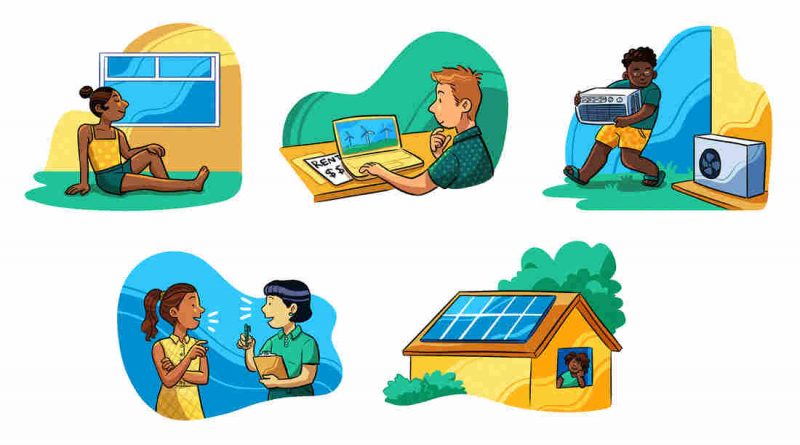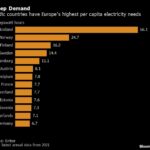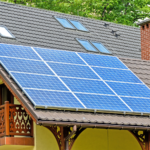5 Ways To Take On Climate Change In Your Home : Life Kit – NPR
Energy Disrupter


Kaz Fantone for NPR
Feeling green? If you’d like to do something to slow down climate change, even if it’s just a small thing, you can get started in your very own apartment or house.
Homes and commercial buildings account for about a third of the country’s greenhouse gas emissions, because it takes energy to heat and cool them and to power all the gadgets that we’ve got plugged in. Much of that energy, whether it’s electricity from a power plant far away or heat from a gas furnace in your basement, comes from burning fossil fuels, which releases greenhouse gases.
But you can change that! “If you want to do something about climate change, your home is among the most important places to look,” says Donnel Baird, CEO of BlocPower, a startup company that’s carrying out energy upgrades of buildings in several cities, including New York.
Start with simple steps.

Rather than relying on a thermostat to control the temperature, try natural ventilation to cool your home in summer. Kaz Fantone for NPR hide caption
toggle caption
Kaz Fantone for NPR
We talked to experts and collected tips for how to proceed. Rohini Srivastava, a senior researcher at the American Council for an Energy Efficient Economy, says it makes sense to start with small, simple, and cheap steps that save energy.
For instance, there’s that energy-control device called a thermostat. “I would start off with heating and cooling my space smartly,” Srivastava says. That could mean relying more on natural ventilation to cool your home in summer, while turning the thermostat down during the night in winter and staying cozy with more blankets instead. If you don’t fight the seasons quite so aggressively, your heater and air conditioner won’t have to work so hard.
Another simple fix: Seal the cracks and holes around the house that allow air to blow through. You may have to learn about caulking and weatherstripping, but you can pick up all you need to know at your local hardware store.
Finally, if you have old-style incandescent light bulbs in your house, go buy LEDs instead. And stop electronic devices like televisions and laptop computers from sipping power all night long. Plugging them into a power strip makes it easy to disconnect them at night, and a “smart power strip” will even do it for you.
When you don’t own the equipment, get creative.

If you pay your own utilities, you often can buy clean electricity. Kaz Fantone for NPR hide caption
toggle caption
Kaz Fantone for NPR
Bigger moves to cut energy use often involve major appliances like furnaces and water heaters, and that’s an obstacle for people who don’t actually own that equipment.
It’s a real hurdle, but even renters and condo owners have some options.
For instance, if you’re paying your own utilities, you often can buy clean electricity. In many states, including California, Texas, and most of the Northeast, you can get your power from companies that purchase wind or solar electricity and add it to the grid for you to use. In many places you can also buy a share in a solar project nearby, called “community solar.”
You may even be able to put a little pressure on your landlord or condo association. “We want you to open up a conversation with the owner and or manager of your building,” says Donnel Baird, CEO of BlocPower. “Are they saving you enough money by using modern green energy technologies that can reduce your monthly utility bill?“
To help you figure out what might be possible in your building, BlocPower has a web site that lets anyone enter basic information about their building, and then offers energy-saving recommendations.
Take a close look at the biggest energy hogs in your home.

Switching to a more efficient appliance can make a big difference in energy consumption. Kaz Fantone for NPR hide caption
toggle caption
Kaz Fantone for NPR
Some of the biggest changes you can make to reduce your carbon footprint involve big-ticket items like furnaces, air conditioning units, and water heaters. If any of these appliances are old, they’re probably a lot less efficient than the latest technology. A switch may also provide an opportunity to shift from gas, which inevitably releases carbon dioxide, to electricity, which is becoming cleaner as electric utilities shut down coal-burning plants and shift toward zero-carbon sources like solar and wind.
Fighting Climate Change From Home
“You want to turn your building into a Tesla, just like Tesla is taking fossil fuel engines out of vehicles, you want to take fossil fuel equipment out of your home,” says Donnel Baird.
An efficient alternative to gas heating is often an electric heat pump, which can handle your cooling as well. Heat pumps work on the same principle as a refrigerator; they can move heat from outdoors to indoors, or the other way around. They’ll heat your home in winter, and cool it in summer. There also are water heaters that use heat pumps. In the past, heat pumps have not worked well when the weather gets really cold, but the technology has improved dramatically in recent years.
They cost thousands of dollars, though, and deciding whether to make the switch can be complicated.
Get some help and advice from the pros.

A home energy audit can point out ways to increase the efficiency of your space. Kaz Fantone for NPR hide caption
toggle caption
Kaz Fantone for NPR
You may need some help figuring out exactly what makes sense to do in your particular house. In many cases, utilities offer rebates to encourage people to buy more efficient equipment, and “they might have recommendations for contractors who can come in and help you understand … what’s the best option,” says Rohini Srivastava.
You might also consider a home energy audit. In some cases, these may be subsidized by utilities or local governments. Otherwise, they’re likely to cost around $400 to $500.
Cheng Vang, with the Center for Energy and Environment in Minnesota, trains energy auditors. He says an auditor will have a long list of items to check, starting with insulation in the attic, walls, and air leaks. An auditor will check all the systems, to see how efficient they are. They’ll probably do a “blower door test,” which sucks air out of the house in order to detect hidden air leaks.
The audit will lay out various options for improving the building’s performance. Sometimes they’ll go further, and provide a rough estimate for how much each option will cost and how much it will save in utility bills — or greenhouse emissions.
See if your house can generate its own electricity.

A solar company should be able to draw up a proposal that lays out the cost and the effectiveness of solar for your home. Kaz Fantone for NPR hide caption
toggle caption
Kaz Fantone for NPR
Solar panels on rooftops used to be a novelty, but in some places they’re now quite common. Donnel Baird says that for many companies, “solar installation is very, very sophisticated and very straightforward. They use satellite imagery to look at your roof. They can see if you have a tree that’s going to shade part of the solar panel. So it’s one of the simpler things that you can do.”
Whether these systems are affordable for you will vary tremendously, because some places, like Washington, D.C., offer generous financial incentives. But a solar company should be able to draw up a proposal that lays all that out.
If you have the space and the sunlight and the money, you can supply your home with its own clean power — at least while the sun is shining.
The podcast and digital versions of this episode were produced by Clare Lombardo. Josh Newell provided engineering support.
We’d love to hear from you. Leave us a voicemail at 202-216-9823, or email us at LifeKit@npr.org.
For more Life Kit, subscribe to our newsletter.
Original Source: https://www.npr.org/2021/04/08/985307540/taking-on-climate-change-at-home-how-you-can-cut-your-homes-carbon-emissions
















